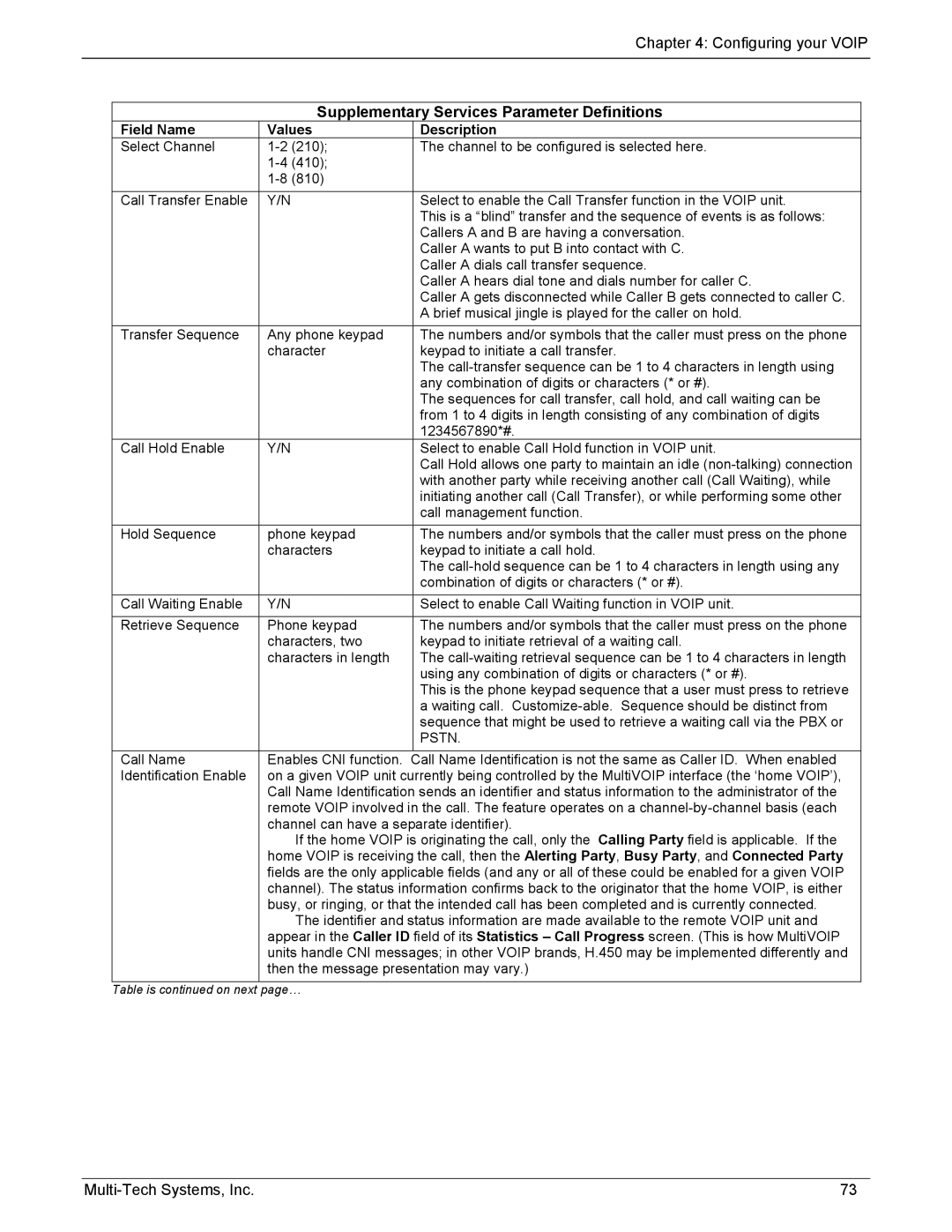
|
|
| Chapter 4: Configuring your VOIP | |
|
|
|
|
|
|
|
|
|
|
|
| Supplementary Services Parameter Definitions | ||
| Field Name | Values | Description |
|
| Select Channel | The channel to be configured is selected here. |
| |
|
|
|
| |
|
|
|
| |
|
|
|
|
|
| Call Transfer Enable | Y/N | Select to enable the Call Transfer function in the VOIP unit. | |
|
|
| This is a “blind” transfer and the sequence of events is as follows: |
|
|
|
| Callers A and B are having a conversation. |
|
|
|
| Caller A wants to put B into contact with C. |
|
|
|
| Caller A dials call transfer sequence. |
|
|
|
| Caller A hears dial tone and dials number for caller C. |
|
|
|
| Caller A gets disconnected while Caller B gets connected to caller C. |
|
|
|
| A brief musical jingle is played for the caller on hold. |
|
|
|
|
|
|
| Transfer Sequence | Any phone keypad | The numbers and/or symbols that the caller must press on the phone | |
|
| character | keypad to initiate a call transfer. |
|
|
|
| The |
|
|
|
| any combination of digits or characters (* or #). |
|
|
|
| The sequences for call transfer, call hold, and call waiting can be |
|
|
|
| from 1 to 4 digits in length consisting of any combination of digits |
|
|
|
| 1234567890*#. |
|
| Call Hold Enable | Y/N | Select to enable Call Hold function in VOIP unit. |
|
|
|
| Call Hold allows one party to maintain an idle |
|
|
|
| with another party while receiving another call (Call Waiting), while |
|
|
|
| initiating another call (Call Transfer), or while performing some other |
|
|
|
| call management function. |
|
|
|
|
|
|
| Hold Sequence | phone keypad | The numbers and/or symbols that the caller must press on the phone | |
|
| characters | keypad to initiate a call hold. |
|
|
|
| The |
|
|
|
| combination of digits or characters (* or #). |
|
|
|
|
|
|
| Call Waiting Enable | Y/N | Select to enable Call Waiting function in VOIP unit. | |
|
|
|
|
|
| Retrieve Sequence | Phone keypad | The numbers and/or symbols that the caller must press on the phone | |
|
| characters, two | keypad to initiate retrieval of a waiting call. |
|
|
| characters in length | The |
|
|
|
| using any combination of digits or characters (* or #). |
|
|
|
| This is the phone keypad sequence that a user must press to retrieve |
|
|
|
| a waiting call. |
|
|
|
| sequence that might be used to retrieve a waiting call via the PBX or |
|
|
|
| PSTN. |
|
|
|
|
|
|
| Call Name | Enables CNI function. | Call Name Identification is not the same as Caller ID. When enabled | |
| Identification Enable | on a given VOIP unit currently being controlled by the MultiVOIP interface (the ‘home VOIP’), |
| |
|
| Call Name Identification sends an identifier and status information to the administrator of the |
| |
|
| remote VOIP involved in the call. The feature operates on a |
| |
|
| channel can have a separate identifier). |
| |
|
| If the home VOIP is originating the call, only the Calling Party field is applicable. If the |
| |
|
| home VOIP is receiving the call, then the Alerting Party, Busy Party, and Connected Party |
| |
|
| fields are the only applicable fields (and any or all of these could be enabled for a given VOIP |
| |
|
| channel). The status information confirms back to the originator that the home VOIP, is either |
| |
|
| busy, or ringing, or that the intended call has been completed and is currently connected. |
| |
|
| The identifier and status information are made available to the remote VOIP unit and |
| |
|
| appear in the Caller ID field of its Statistics – Call Progress screen. (This is how MultiVOIP |
| |
|
| units handle CNI messages; in other VOIP brands, H.450 may be implemented differently and |
| |
|
| then the message presentation may vary.) |
| |
|
|
|
|
|
Table is continued on next page…
73 |
